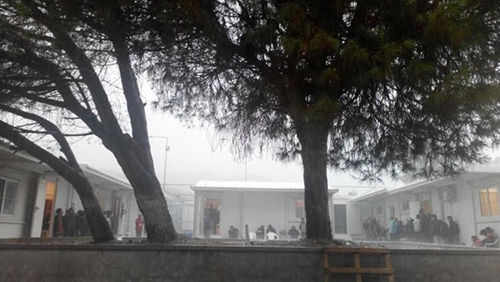Access to a Hot Field: A Self-Reflexive Account of Research in the Moria Camp, Lesvos

Researchers face many obstacles in gaining permission to study migration governance sites as governments seek to avoid accountability. In this post, I reflect on my experience of gaining access to the Moria camp in Lesvos – its denial, its negotiation and its achievement. The importance of the Moria camp and the entire Lesvos island in the emergent geography of the EU border regime as a site of bureaucracy, control and humanitarianism has turned it into a popular field for researchers.
I use the term Moria camp to refer to a fragmented and heterogeneous assemblage of diverse agents and jurisdictions. The Moria camp comprises various sections that fall under the authority of several departments or entire ministries. Thus, there is not one formal chief of the entire site. As employees in the First Reception Service emphasized during my last visit in late September 2017, contrary to a common belief, the Moria camp is not the hotspot. The hotspot is merely a unit within the camp. The camp also hosts a pre-removal detention center where deportable people and asylum seekers are held (under the jurisdiction of the Ministry of Citizen’s Protection) and the Asylum Service (an autonomous body of the Ministry of Migration) supported by EASO officers. Inside the hotspot itself there is an array of agencies that operate: state (the First Reception Service under the Ministry of Migration, the Alien’s Police Department under the Ministry of Citizen’s Protection), supra-state (Frontex), inter-governmental (IOM, UNHCR) and non-state ones. Despite this fragmentation of authorities and jurisdiction, I see the Moria camp as one assemblage that – exactly due to its disjointed character – largely produces illegibility and disorder. Furthermore, these elements of the Moria camp affect any attempts to gain research access.

The hotspot inside the Moria camp during the first days of its functioning, 22 October 2015 (Photo: Katerina Rozakou)
In the summer and autumn of 2015, I conducted research inside the (then) Moria registration and identification center. When I was given permission for fieldwork in the spring of 2015, a rise in arrivals was expected but nobody predicted the magnitude of the phenomenon in the next months. In October 2015, the Moria hotspot was inaugurated. After March 2016 and with the “EU-Turkey Deal”, the Moria camp entered a (proclaimed) new phase in the EU border regime. Between 2015 and 2017, I attempted to reenter the Moria camp either unsuccessfully (April 2016 and July 2017) or successfully (late October 2015, July 2016, and late September 2017).
Access Denied
14 April 2016. It was a special day. Two days later Pope Francis would visit the Moria camp. The preparations were hectic. Inside the camp, an awning with the UNHCR logo was placed outside the hotspot. The exterior wall of the Moria camp was painted in blinding whitening lime and the razor barbed wire was temporarily removed. A vacuum truck was hectically pumping sewage out of the congested facilities. Allegedly, 400 journalists were on the island in order to document the Pope’s visit.
Approaching the Moria camp, I was struck by the traffic. I parked my rented car in the first available spot, a few hundred meters away from the main gate – among other rentals used by reporter crews, EASO and Frontex officers, mini vans embellished by the logos of humanitarian organizations, the private cars of police officers, civil servants and NGO/IGO workers and a riot police bus. Besides, border-crossers occupied the two sides of the road. Men, women and children walked to the neighboring villages and to the capital of the island, Mytilene, or hang out waiting for their registration procedures to be completed in order to leave the island. These were the lucky ones who had arrived before 21 March 2016 and the implementation of the “EU-Turkey Deal”. Other border-crossers who had arrived to Lesvos after that would remain under administrative detention in the Moria camp and then, after 28 days, on the island for an indefinite period.
The aim of my visit was to record the changes that had occurred after the implementation of the “EU-Turkey Deal”. For several weeks, I had repeatedly asked for official permission to visit the Moria camp in vain. Different authorities – the Ministry of Migration and the Ministry of Citizen’s Protection – either did not reply to my emails or claimed that they had no jurisdiction. Nevertheless, I now stood in front of the Moria camp.
As we tend to think of ourselves as dedicated researchers engaged in a noble and strenuous quest of knowledge production, we are often shocked by our research participants’ aggressive responses or their unwillingness to participate in our endeavors. It is unquestionably different to be rejected by an over-researched vulnerable group than by a state agent who safeguards a migration governance site. It is different to be kicked out of a village by people whose life has been misrepresented by ethnographers than by a migration agency that fears that revealing its actual practices would threaten its humanitarian façade. However, as anthropologists we remain devoted to the ethical principles of a discipline that bears the burden of its past colonial affiliations. We thus need to be alarmed about reproducing neo-colonial research attitudes even when we do fieldwork with agents of the state who work in migration governance sites.
“People come and say ‘I am writing an article’. They just appear on the front gate and they demand to enter. Everybody uses the same excuses: I want to see how the space has changed; I am not like the others [researchers, journalists]; I have a different approach; I am not visiting the zoo.” The thirty-five-year-old head of the Moria hotspot was visibly upset. Standing at the gate of the Moria camp and listening to her accusations, I felt frustrated and angry. I was less upset about my unsuccessful ERC-sponsored trip to Lesvos than by the moral overtones of her accusations. In her eyes, I was just “another” researcher, similar to the detested journalists who craved for an easily digested account and a simplified image. Other Moria camp employees were less blunt in putting me within this framework: the voyeuristic and opportunistic “visitors to the zoo”. Yet, they all scrutinized the unproductive character of such visits – including my own.
Access Granted
28 September 2017. “I am well aware of the kind of job that people who visit Moria [sic] do. They come here on one occasion and then they are gone. They write a report or a newspaper article. They can easily criticize the living conditions.” The First Reception Service employee has been working in the hotspot for the last year. Her disapproving comment came only two days after the Council of Europe’s Committee for the Prevention of Torture and Inhuman or Degrading Treatment or Punishment (CPT) published a critical report on the detention of unaccompanied minors.
Many suspicious camp employees that I met told me they were used to receiving multiple visitors a day: journalists, academics from (almost exclusively) foreign institutions, human rights groups’ researchers, and EU officials. Despite the dominant impression that access is very much restricted, it seems that it is actually given fairly frequently. Yet, it is mostly a partial access, limited to one or two-day visits.
However, researching migration governance sites is valuable and I believe that we should fight for as extensive access as possible. We need to try to bring to the fore the experiences of the people involved – as state, supra-state and non-state functionaries or as border-crossers detained, illegalized and deported. What is vital is a research on the mundane aspects of bureaucracy, humanitarianism, policing, and the production of illegality (to name a few).
During this visit, I was struck by the advanced role and unhindered access that volunteers had – compared to researchers, for example. Eurorelief was one of the few voluntary groups that remained in the Moria camp after the implementation of the “EU-Turkey Deal”. Since then, this Evangelical organization has blossomed. Hundreds of its volunteers have served in the Moria camp over the last two years, being responsible for crucial functions such as the settlement of newly arrived border-crossers in containers or opening and closing the gate of the hotspot – a threshold of power. Sovereignties overlapped or even reversed.
In lack of official permission or due to the restrictions that come with it, some researchers resort to entrance through the humanitarian field whereas others attempt to access the migration apparatus as workers in migration and asylum services. A humanitarian’s vest is certainly not a neutral outfit. In fact, apart from affecting the initial way people in the camp receive the newcomer, such strategies often reproduce a total disregard of informed consent. Of course, a one-time visit is far from enough to produce an ethnographic study or any informed account of the hotspot. Instead of aspiring to illuminate the perspective of specific actors, such visits merely serve as the validation of an account that could simply be written from a distance.
Katerina Rozakou
Postdoctoral researcher, Faculty of Social and Behavioral Sciences, University of Amsterdam
This is a shortened version of a post published on 9 November 2017 on the Border Criminologies Blog in the themed series on “Accessing the Migration Apparatus” organized by Damian Rosset and Christin Achermann, University of Neuchatel and nccr – on the move. The series originates from a panel that took place during the 2017 IMISCOE Annual Conference in Rotterdam. It reflects on the way access shapes the researchers’ position and the scientific knowledge they produce.


